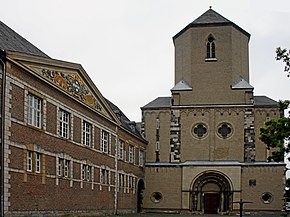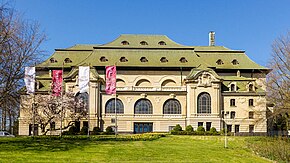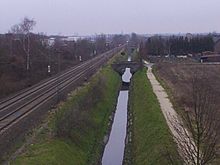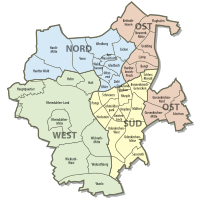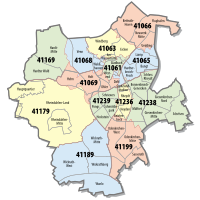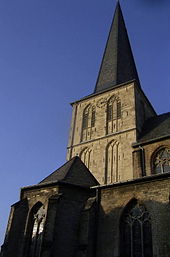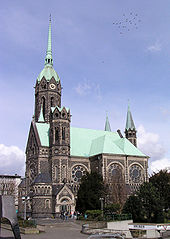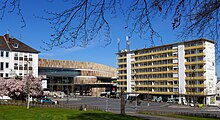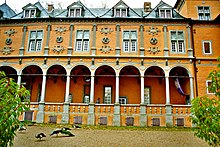Mönchengladbach
| coat of arms | Germany map |
|---|---|

|
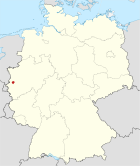
Coordinates: 51 ° 12 ' N , 6 ° 26' E |
| Basic data | |
| State : | North Rhine-Westphalia |
| Administrative region : | Dusseldorf |
| Height : | 70 m above sea level NHN |
| Area : | 170.47 km 2 |
| Residents: | 261,034 (Dec. 31, 2019) |
| Population density : | 1531 inhabitants per km 2 |
| Postcodes : | 41061-41239 |
| Primaries : | 02161, 02166 |
| License plate : | MG |
| Community key : | 05 1 16 000 |
| LOCODE : | DE MGL |
| NUTS : | DEA15 |
| City structure: | 4 city districts , 44 city districts |
City administration address : |
Rathausplatz 1 41050 Mönchengladbach |
| Website : | |
| Lord Mayor : | Hans Wilhelm Reiners ( CDU ) |
| Location of the city of Mönchengladbach in North Rhine-Westphalia | |
Mönchengladbach is an independent German city in the west of North Rhine-Westphalia . The city, classified as a regional center , is located in the administrative district of Düsseldorf , it is also part of the Rhine-Ruhr metropolitan region . The urban area of Mönchengladbach extends north of the Niersquelle , the Mönchengladbach city center is located around 25 kilometers west of the North Rhine-Westphalian capital Düsseldorf .
The city of Mönchengladbach has existed in its current boundaries since the territorial reform that came into force on January 1, 1975, after the (old) independent city of Mönchengladbach was united with the independent city of Rheydt and the municipality of Wickrath ( Grevenbroich district ) to form the new independent city of Mönchengladbach .
The population rose to over 100,000 for the first time in 1921. On December 31, 2019, the population of the entire city was 261,034.
With Mönchengladbach Hauptbahnhof and Rheydt Hauptbahnhof , Mönchengladbach is the only city in Germany to have two main train stations.
geography
Location and surroundings
Mönchengladbach is located about 16 kilometers west of the Rhine in the Lower Rhine lowlands on the eastern slope of the Schwalm-Nette-Platte against the loess-covered Kempen-Aldekerker-Platte and the Niers lowland . Although Mönchengladbach is mostly in the lowlands, the south (Odenkirchen district) and the city center (around Bökelberg and Abteiberg) are relatively hilly. These ranges of hills are limited to the interior of the city. Large parts of the urban area are covered by forests and parks. The Hardter Forest and parts of Rheindahlen in the west belong to the Maas-Schwalm-Nette Nature Park .
The highest point is at 133 m above sea level. NN after the Second World War Rheydter Höhe piled up from rubble . The lowest point is the Nierswiesen in the Donk district at 35 m above sea level. NN . The total length of the city limits is 86 kilometers. The largest north-south extension is 17; the largest west-east extension 18 kilometers. The center of the urban area is in the Pongs district.
Waters
All waters that have their source in Mönchengladbach (or those that originated there in the past) are influenced by the open - cast lignite mine - Garzweiler II - which takes place south of Mönchengladbach. The area is approaching Mönchengladbach; the environmental impact is significant.
Gladbach
The Gladbach , which gave the city its name, had its source in the district of Waldhausen in or near the former Hensen brewery. Today this has dried up. The Gladbach Canal, which was originally also fed by the Gladbach spring, runs largely underground along the old stream bed and flows into the Niers in the east of the city. It can be seen in Lürrip up to the confluence with the Niers. The course of the former Gladbach is marked by signs in the city.
Niers
The Niers flows through the south and east of the urban area , which used to arise a few hundred meters south of the city limits of Erkelenz near Kuckum in the Heinsberg district. As a result of the swamp measures in the course of the Garzweiler II opencast mine and the associated loss of the Kuckum site, the Niersquelle was relocated to the Mönchengladbach golf course in April 2006. Since then, the Niers has risen in the water hazard between lanes 12 and 17 and then crosses the fairways of lanes 18 and 1 back into its old river bed. The Niers leaves the urban area in the north of the city on the border with Viersen not far from the trotting track before the river flows into the Meuse at Gennep in the Netherlands .
Schwalm
The Schwalm rises to the southwest of the city limits (in Wegberg ) . It flows into the Meuse near Swalmen in the Netherlands. One of the rivers that has its source in Mönchengladbach's urban area and flows into the Schwalm is the Knippertzbach .
Neighboring communities
The following cities and municipalities border the city of Mönchengladbach. They are called in clockwise order , starting in the northwest:
Schwalmtal , Viersen and Willich (all districts of Viersen ), Korschenbroich and Jüchen ( Rhein district of Neuss ) as well as Erkelenz and Wegberg ( district of Heinsberg ).
Urban area and urban structure
The urban area of Mönchengladbach has consisted of four (previously ten) districts , which are divided into 44 districts , since 2009 . Each city district has a district council chaired by a district head . The district councils are to be heard on important matters relating to the district and are re-elected at each local election.
The city districts with their associated districts
Districts and districts:
- North : Am Wasserturm , Dahl , Eicken , Gladbach , Hardt-Mitte , Hardter Wald , Ohler , Venn , Waldhausen , Westend , Windberg
- East : Bettrath-Hoven , Bungt , airport , Giesenkirchen-center , Giesenkirchen-north , Hardterbroich-Pesch , Lürrip , Neuwerk-center , Schelsen , Uedding
- South : Bonnenbroich-Geneicken , Geistenbeck , Grenzland-Stadion , Heyden , Hockstein , Mülfort , Odenkirchen-Mitte , Odenkirchen-West , Pongs , Rheydt , Sasserath , Rheydt Castle , Schmölderpark , Schrievers
- West : Headquarters , Hehn , Holt , Rheindahlen-Land , Rheindahlen-Center , Wanlo , Wickrath-Center , Wickrath-West , Wickrathberg
Further information on the subject can be found in the list of districts and districts of Mönchengladbach .
Cadastral areas
| Settlement areas | 6,270 ha | 36.8% |
| Traffic areas | 2,096 ha | 12.3% |
| free space | 8,680 ha | 50.9% |
| total area | 17,045 ha | 100.0% |
|---|
City history
Surname
More than 20 different spellings of the city name have been known since the 10th century. a. Gladebach , Monichgladebach , Moenchsgladbach , Monnike Gladbeeck and Munneke Glebbek . Until the end of the 19th century, the city was called Gladbach in alternating spellings . When Gladbach became a district on January 1, 1888, it was given the name Munich-Gladbach , abbreviated M. Gladbach , to better distinguish it from Bergisch Gladbach . The name is derived from the monks who have settled in Gladbach since 974 .
From August 1, 1929 to July 31, 1933, Munich-Gladbach, together with Rheydt and other communities, was part of the independent city of Gladbach-Rheydt with around 200,000 inhabitants. After its dissolution it was called Munich Gladbach (without hyphen), again abbreviated M. Gladbach .
On December 20, 1950, the pronunciation in Mönchen Gladbach was changed while maintaining the spelling M. Gladbach in order to avoid confusion with Munich . On October 11, 1960, the form Mönchengladbach, which is still in use today, was introduced, which was also chosen when Rheydt and Wickrath were merged again on January 1, 1975 due to the Düsseldorf Act ; this choice of name was controversial among the population.
First human traces
The first settlements in the area of today's Mönchengladbach are around 300,000 to 400,000 years old and show evidence of the late Homo erectus (= Homo heidelbergensis ) and the Neanderthal man . Sites were discovered mainly in the southern part of today's urban area around the Niers and southeast of Rheydt Castle .
Early history
In 2013, researchers found a Paleolithic settlement south of Rheydt Castle , on the former right-hand side of the Niers , which shows that 13,500 years ago people lived from hunting in the vicinity of the Niers.
From the Neolithic and the Bronze Age many are tumuli in Hardter forest preserve, which already belonged to a peasant culture. Other finds were made mainly in the area around Mülfort, Wickrathberg, Giesenkirchen-Nord, Giesenkirchen-Mitte, Wanlo and Rheindahlen. Around 50 BC BC, when the first Roman troops under Caesar arrived, the Celtic area, presumably belonging to the Eburones , was suddenly uninhabited, and the population was probably murdered by the Romans.
Roman settlement
In Roman times the area of today's Mönchengladbach belonged to the province of Germania inferior . There existed in the 1st to 3rd centuries, in Mönchengladbach-Mülfort, a Roman street village ( Vicus Mülfort ) with a ford over the marshy Niers and important road connections to Roman Neuss and the Maas. After the destruction of the Roman village by the Franks in 352 AD, the area was uninhabited.
Middle Ages and early modern times
Around 800 AD Franconians settled in the area of today's Odenkirchen-Sasserath, Wickrath and on the Abteiberg. In 974 the Gladbach Minster was built and an abbey was founded by Archbishop Gero of Cologne and his companion, the Trier monk Sandrad . The construction of the first monastery church took place next to the place where in 954 the Hungarians destroyed the church built by Balderich , a nobleman of the empire , shortly before 800.
The monks drove a settlement and in the 12th century created a market north of the church. Craftsmen and tradespeople settled here in the years that followed. City rights were granted in the years 1364-1366. The city received a stone city wall that had to be maintained by the citizens (remnants of it are still preserved on the Geroweiher, as well as the thick tower , a defensive tower on Waldhausener Berg and at the back of Kapuzinerplatz). Until the end of the 18th century, the city belonged to the Grevenbroich office in the Duchy of Jülich .
French period
On October 4, 1794, French revolutionary troops marched into the city area. The Jülich Fortress had been handed over the day before . When the German Emperor Franz II ceded the left bank of the Rhine to France in the Peace of Lunéville in 1801, Gladbach was subjected to French religious laws. The abbey was dissolved; the last 31 monks left the monastery on October 31, 1802. The important library of the abbey, known beyond the borders of Germany, was largely robbed or destroyed. From 1798 to 1814 Mairie Gladbach belonged to the canton of Neersen in the Arrondissement de Crévelt in the French department de la Roer .
Prussian rule and empire
From 1815 Gladbach was under Prussian administration and became the seat of the Gladbach district , which was dissolved in 1929. In this context, Gladbach also became the seat of the mayor's office of the same name , which was divided into the city of Gladbach and the Obergeburth mayor's office in 1859.
On October 24, 1890, the Volksverein was founded in Cologne , but chose M. Gladbach as its seat. In 1907, the Obergeburth mayor's office was renamed the Munich-Gladbach-Land mayor's office. City district and district town in the Prussian administrative district of Düsseldorf , to the left of the Rhine (1919) 64,031 inhabitants, together with the Rheydt to the south, forming a closed residential area for around 130,000 inhabitants. District Court , Chamber of Commerce , Gymnasium and Realgymnasium , Lykeion (one with advanced training), higher technical college for the textile industry; Seat of the Volksverein for Catholic Germany. Headquarters of the Rhenish textile industry (including cotton spinning mills, weaving mills, dye works), iron foundries, machine factories . The rural community Munich-Gladbach had 22,614 inhabitants.
Weimar Republic and National Socialism
In 1921 the city of Rheindahlen, the mayor's office in Munich-Gladbach-Land and Neuwerk were merged with the city of Munich-Gladbach. In 1929 Munich-Gladbach was united with Rheydt and other communities (including Rheindahlen , Hardt , Giesenkirchen and Odenkirchen ) to form the twin town of Gladbach-Rheydt , but divided again in 1933 (at the request of Reich Propaganda Minister Joseph Goebbels , who was born in Rheydt). After that, Alt-München-Gladbach was officially called München Gladbach (without hyphen) or M. Gladbach for short .
The second World War
On the night of Pentecost Sunday (May 11th and 12th) 1940, Royal Air Force (RAF) aircraft launched air raids on 15 individual targets in the Aachen-Mönchengladbach-Düsseldorf-Viersen area. The first bombing hit Mönchengladbach, killing four people. The Wehrmacht began the campaign in the west on May 10, 1940 ; the Aachen – Mönchengladbach line was used to transport troops and vehicles. The attack was not directed (as sometimes claimed) against the city, nor was it the start of the Royal Air Force's area bombing of German cities.
The heaviest major attack on Munich-Gladbach and Rheydt in World War II took place on the night of August 30th to August 31st, 1943. During the last major attack on February 1, 1945, 160 aircraft dropped 1,200 high-explosive bombs and 65,000 incendiary bombs. At the end of the war, around two thirds of the two cities had been destroyed, and around 2,000 civilians had died in the air raids.
Between February 26 and March 1, 1945, the area of today's Mönchengladbach was conquered by the Allies from the south during Operation Grenade . A hospital unit, the 41st Evacuation Hospital with 750 mobile beds, was stationed in the Grenzlandstadion from March 4 to April 2, 1945. Elsewhere in Germany, the war continued until the beginning of May.
In the last days of the war, US troops set up the nine-square-kilometer Wiesenlager Wickrathberg prisoner-of-war camp between Mongshof , Wickrathberg and Hochneukirch , which was later also led by the British armed forces. At least 150,000 German soldiers lived there when fully occupied. The soldiers spent the entire time outdoors in very harsh conditions and mostly slept in holes they dug themselves. The food was also very sparse. Witnesses said 20 deaths a day, others a total of 226 deaths. The exact death toll is unknown. The camp existed from April to September 1945.
Post-war until today
After the war, the textile industry slowly regained importance in both cities; later it was supplemented by mechanical engineering. In 1974 the city had a total of 147,567 inhabitants, of which Alt-Mönchengladbach 81,756 (of which in turn Stadtmitte 58,511 and Volksgarten 23,245), Rheindahlen 27,707, Hardt 17,142 and Neuwerk 20,962. In the course of the regional reform in North Rhine-Westphalia , Mönchengladbach, Rheydt and the municipality of Wickrath were merged in 1975.
religion
Denomination statistics
According to the 2011 census , 51.9% of Mönchengladbach's population were Catholic, 18.3% Protestant and 29.8% belonged to any other or no public religious community - the latter also include Mönchengladbach Muslims. The number of Protestants and Catholics has fallen since then. Currently (as of December 31, 2019) Mönchengladbach has 261,034 inhabitants, 120,768 (46.3%) Catholics , 40,950 (15.7%) Protestants and the remaining 38.0% either have another religion or no religion at all. The statistics of the Diocese of Aachen at the end of December 2017 showed Mönchengladbach with a total of 262,188 inhabitants, 126,036 Catholics (48.1%).
Christianity
Mönchengladbach and Rheydt initially belonged to the diocese of Liège . Under Archbishop Everger of Cologne († 999) the area came to the Archdiocese of Cologne and was subordinate to the Archdeaconate of the Provost of St. Viktor's Cathedral in Xanten , the Deanery of Süchteln . However, the Gladbach Abbey was relatively autonomous and exercised ecclesiastical rights over the city of Gladbach. The area remained with the Archdiocese of Cologne until 1802. After the Reformed Confession , the Reformation was initially able to gain a foothold in Gladbach, but then, due to the abbot's resistance, it did not prevail, so that Gladbach remained a predominantly Catholic city. In the 16th and 17th centuries, however, there was still a radical Reformation Anabaptist community in the city , which, despite several confiscations and expatriations, lasted until the last wave of expulsions in 1722. The community, which is assigned to the High German Mennonites , is said to have introduced the weaving mill in Gladbach , among other things . Voices in the city to tolerate the Anabaptists in Gladbach for economic reasons were not implemented. At the beginning of the 17th century, the other Protestants were able to hold their services in the “hall” on the market. In 1684 they were able to build a church on the east side of the city in front of the city wall; this was canceled in 1857. The construction of today's Christ Church in Kapuzinerstraße took place until 1852. Towards the end of the 19th century, around 80 percent of the population were Catholic and 20 percent were Protestants.
It was different in Rheydt: the Reformation movement began there around 1550. In 1560 there were Reformed clergymen. In 1632 the pastors and the community in Rheydt converted to Protestantism under pressure from the Protestant ruling house of Jülich . They were subordinate to the Jülich Provincial Synod and the Gladbacher Quartier. Therefore Rheydt was a predominantly Protestant city. In the 19th century, more and more Catholics moved here in the course of industrialization, so that the numerical ratio of the two denominations was relatively even; later this changed greatly in favor of the Catholics.
In 1802, the Catholic parishes were assigned to the newly founded diocese of Aachen , which was abolished in 1821/1825, so that the Gladbach / Rheydt area came back to the re-established Archdiocese of Cologne from 1821 . In 1930 it was assigned to the newly established diocese of Aachen. Mönchengladbach and Rheydt became seats of deaneries and today all parishes in the city of Mönchengladbach belong to the Mönchengladbach region . The main church of the city is the Mönchengladbach Minster .
With the transition of the Duchy of Jülich to Prussia in 1815, the Protestant communities of Gladbach and Rheydt as well as the communities of today's districts of Mönchengladbach became members of the Protestant Church in Prussia from 1817 ( uniate church ) or its Rhenish provincial church. Gladbach became the seat of a superintendent, from which later the parish of Gladbach (today Gladbach-Neuss) emerged within the Protestant church in the Rhineland . In the 1960s, the parishes of Mönchengladbach and Rheydt were divided into several parishes. However, all parishes in today's city belong to the parish of Gladbach-Neuss, which also includes parishes outside the city of Mönchengladbach. Protestant parishes in the city are now the parishes of the following churches: Christ Church, Friedenskirche, Großheide, Hardt, Odenkirchen, Rheindahlen (Martin Luther), Rheydt and Wickrathberg.
On September 4, 2009, the Rheydt Youth Church in Mönchengladbach was officially opened. Its focus is the house of the youth church in the center of Mönchengladbach-Rheydt. Here the selective youth work and the forces from the various districts are bundled under one roof. The youth church house is a former nurses' home and belongs to the Protestant parish Rheydt.
The following free churches are represented in Mönchengladbach: since 1867 an Evangelical Free Church congregation ( Baptists ), a Christian congregation (a Pentecostal congregation in the BFP ), and the Seventh-day Adventists . Furthermore, the Free Evangelical Congregation, FeG for short, has a church planting project with regular church services in Mönchengladbach. The Church of the United Methodist Church was dissolved in 2009.
There are also other Christian religious associations: the Christian Community , the New Apostolic Church , the Mormons ( Church of Jesus Christ of Latter-day Saints ) and the Christadelphians .
Judaism
From the 18th century until the 1930s, there was a Jewish community in Wickrath and Odenkirchen . In the 19th century there was one synagogue each in Mönchengladbach, Wickrath, Rheydt and Odenkirchen. In November 1938 pogrom they were destroyed. After the Second World War, a Jewish community was formed again in Mönchengladbach . In 1967 a new community center with a synagogue was inaugurated (community center with prayer hall).
Islam
In the last few decades, a larger Muslim community has formed in Mönchengladbach, consisting primarily of immigrants from Muslim countries and their descendants. Mosques are operated by the Islamic associations Turkish-Islamic Union of the Institute for Religion / DITIB (Diyanet Merkez Camii / Center Mosque), Association of Islamic Cultural Centers / VIKZ and Millî Görüş / IGMG (Hz.-Bilal-Mosque) and the ar-Rahman associations (in Arabic ), Nimet Vakfi ( Dergah ), Islamic Cultural Association of Roma and IAIK Masjid Hijrat e. V. (on Pashto and Dari ). In 2012, the previously Evangelical-Methodist Church of the Cross was given to the local Alevis as the new Cem community hall. In 2011, after long disputes in Mönchengladbach-Eicken, a citizens' initiative prevented the opening of a radical Salafist mosque.
Incorporations
The French occupation was formed in 1798 from the old, formerly belonging to the Duchy of Jülich Office Gladbach with the city Gladbach five mayors:
- Gladbach
- Obergeburth consists of the honors Dahl, Ohler, Holt, Hehn, Winkeln , Venn, Großheide, Windberg, Waldhausen, Hamern, Rönneter, Poeth, Beltinghoven and parts of Speick, Hermges and Vorst
- Oberniedergeburth consisting of the honors Eicken, Üdding, Lürrip, Bungt, Hardterbroich, Pesch and parts of Speick and Hermges
- Unteriedergeburth with the honors Bettrath, Hoven, Donk and Damm
- Hardt consisting of the honors Hardt, rattles and parts from Vorst
Just two years later, in 1800, Hardt was assigned to the mayor's office in Gladbach, but there was still an administrative office of its own until January 1, 1807. On January 1, 1836, however, Hardt regained his independence and was expanded to include the honors Hehn and Winkeln as well as the remaining part of Vorst, which until then had all belonged to the Obergeburth mayor. The rest of Obergeburth was incorporated into Gladbach, as well as the honors Eicken, Hardterbroich and parts of Lürrip, which until then belonged to the mayorry of Oberniedergeburth. The rest of Oberniedergeburth (Üdding and Lürrip partly.) Was merged with Unteriedergeburth to form the Neuwerk community. Thus, from 1836 there were still three communities: the city of Gladbach and the communities of Hardt and Neuwerk . Gladbach was still divided into the three special communities Gladbach, Oberniedergeburth and Obergeburth . Parts of Obergeburth were in 1859 as a community Obergeburth spun off, while the other parts Obergeburths and Oberniedergeburth belonged since 1857 to the city Gladbach, under the name "München-Gladbach" to January 1, 1888 acyclic was. On January 1, 1907, the Obergeburth mayor's office was renamed Gladbach-Land , before it was incorporated into Munich-Gladbach on August 1, 1921 with the municipality of Neuwerk and the city of Rheindahlen ( town charter since 1354, only Dahlen until 1876).
On August 1, 1929, the independent city of Munich-Gladbach was merged with the municipality of Hardt, the independent city (since 1907) Rheydt, the city of Odenkirchen and the Schelsen office (with the municipality of Giesenkirchen) to form the new independent "City of Gladbach-Rheydt" . But this city was already divided into two cities on August 1, 1933: City of "Munich Gladbach" (with Hardt) and city of "Rheydt" (with Odenkirchen, Giesenkirchen and Schelsen).
Both cities were then within the North Rhine-Westphalian government reform on 1 January 1975, community involvement Wickrath (formed in 1933 out of office Wickrath with the villages Beckrath , Wickrathhahn , Herrath, Wickrathberg and Buchholz and the community Wanlo) to today's independent city Mönchengladbach united.
Population development
In 1890 around 50,000 people lived in Munich-Gladbach . On August 1, 1921, the independent city of Munich-Gladbach (64,031 inhabitants 1919), the rural communities Munich-Gladbach (22,614 inhabitants 1919) and Neuwerk (11,836 inhabitants 1919) as well as the city of Rheindalen (8308 inhabitants 1919) joined to form the new city of Munich- Gladbach with about 110,000 inhabitants. On August 1, 1929, the incorporation of Rheydt (45,095 inhabitants in 1925), Odenkirchen (20,023 inhabitants in 1925) and other places increased the population of the new urban district of Gladbach-Rheydt to around 200,000. After the spin-off of the city of Rheydt (with Odenkirchen, Giesenkirchen and Schelsen) on August 1, 1933 and the destruction in World War II, the population of Munich-Gladbach halved in 1945 to just 106,000.
On October 11, 1960, the name was changed to Mönchengladbach . In 1968 the population of the city of Rheydt exceeded the limit of 100,000, making it a major city. The incorporation of Rheydt (99,963 inhabitants) and Wickrath (13,961 inhabitants) on January 1, 1975 brought an increase from 114,000 people to 263,000 inhabitants. In 1996, the city's population reached its historic high of 266,873. On June 30, 2018, the official population for Mönchengladbach was 262,070 according to the information and technology department of North Rhine-Westphalia (only main residences and after comparison with the other state offices ).
population
| Total inhabitants (EW) | 261,034 1 |
| Proportion of foreigners [%] | 11.4 1 |
| Population density [population / km²] | 1531 1 |
| Resident employees subject to social insurance (SvB) | 82,406 2 |
| Commuters | 37,935 2 |
| Commuters | 35,246 2 |
politics
History of the Council and the Lord Mayor
The jury was at the head of the city of Gladbach. There was also a Vogt as a representative of the sovereign. Mayors are mentioned for the first time from 1400 , of whom there were initially six elected for life. These formed the magistrate . Three were lay judges, the other three were elected by the city council. If a lay judge was eliminated, the lay judge appointed by the bailiff took his place. If one member was eliminated from the members elected by the citizens, a new one was elected from several candidates. From the entire magistrate, two mayors alternated annually as ruling and associate mayors. They ran the city administration. There was a council for the first time since 1446, the chairman of which was the ruling mayor. In French times, the municipal constitution was introduced from 1797. The city head was the honorary "Maire", who was assisted by two honorary councilors and a municipal council. In 1815 the Prussian mayor's constitution was adopted, in 1845 the municipal code of the Rhine Province and in 1856 the Prussian town code . After that, a mayor or, from 1869, usually a lord mayor headed the city administration. He also continued to have advice.
During the time of National Socialism , the mayor was appointed by the NSDAP . After the Second World War , the military government of the British Zone of Occupation appointed a new Lord Mayor and in 1946 introduced the local constitution based on the British model. Then there was a popularly elected “City Council”, whose members are called “City Councilors”. The council initially elected the honorary mayor from among its members as chairman and representative of the city. Furthermore, from 1946 the council also elected a full-time senior city director as head of the city administration. In 1999 the dual leadership in the city administration was given up nationwide. Since then there has only been the full-time mayor. He is chairman of the council, head of the city administration and representative of the city. He was elected directly by the people for the first time in 1999. Monika Bartsch (CDU) was the first directly elected mayor in Mönchengladbach. The offices of the city administration are now distributed among the inner cities of the formerly independent municipalities of Mönchengladbach and Rheydt.
City council
In the XV. The term of office (2009 to 2014) of the Mönchengladbach City Council was represented by seven parties and one group of voters. SPD, Bündnis 90 / Die Grünen and FDP had come together to form a majority on the basis of a cooperation agreement.
For the first time since the Second World War, the CDU was not part of the council majority. The city council consists of 66 city councilors and the directly elected and voting mayor, who chairs the meetings but is not a member of the city council.
- Election of the city council in 2014
| Party / list | Share of votes | Seats |
|---|---|---|
| CDU | 41.5% | 29 |
| SPD | 29.4% | 20th |
| Green | 10.7% | 7th |
| FDP | 4.5% | 4th |
| THE LEFT. | 4.5% | 3 |
| per NRW | 1.9% | 1 |
| FWG | 1.8% | 1 |
| PIRATES | 1.5% | 1 |
| AfD | 1.5% | 1 |
| POLITICAL PARTY | 1.3% | 1 |
| NPD | 0.9% | 1 |
In the XVI. In office (2014 to 2019), nine parties / groups of voters and one non-party member are represented in the council: 29 seats go to the CDU (41.5% of the votes), 20 to the SPD (29.4%), 7 to the Greens ( 10.7%), 3 each on the FDP (4.5%) and Left (4.5%) and one each on Pro NRW (1.9%), the Free Voters (1.8%), the Pirates (1.5%), the PARTY (1.3%) and the NPD (0.9%). The non-party council member who ran for the AfD and later left the party, achieved 1.5%.
In the 2014–2020 election period, the CDU and SPD agreed to cooperate.
Mayor or Lord Mayor since 1800
|
|
City directors 1946–1999
- 1946 : Wilhelm Elfes , CDU
- 1946–1958: Fritz Fleuster
- 1958–1974: Wilhelm Elbers
- 1975–1994: Helmutjoy
- 1994–1999: Jochen Semmler
Indebtedness
The total amount of debt of the city of Mönchengladbach in mid-2020 was 948.69 million euros.
City coat of arms and city flag

|

|

|
|
| Banner, coat of arms and flag | |
The city of Mönchengladbach was granted the right to use a coat of arms and a flag in a certificate from the District President in Düsseldorf dated February 7, 1977 . Walther Bergmann designed the coat of arms .
The heraldic description of the coat of arms reads as follows:
“ Under a red shield head, inside a silver pinnacle bar, split by blue and gold, in front a silver curved bend, behind a continuous black cross. "
The changing bar stands for the Lords of Quadt , who ruled Wickrath until 1796. The abbot stands for the Benedictines who lived on the Abteiberg Mönchengladbach until 1802 and the cross symbolizes the Lords of Bylandt , who ruled Rheydt.
- Description of the flag
The city of Mönchengladbach carries a banner red-gold (yellow) -red in a ratio of 1: 4: 1, striped lengthways with the coat of arms of the city shifted upwards over the middle, as well as a flag red-gold (yellow) -red 1: 4: 1 striped across with the coat of arms of the city shifted to a pole.
The old town of Mönchengladbach had a different coat of arms from 1903 to 1929 and from August 1, 1933 to December 31, 1974, showing St. Vitus and a black lion, both separated by a blue wavy bar. St. Vitus is the patron saint of the Benedictine abbey and thus of the city, the lion the heraldic animal of the Lords of Jülich, who elevated the Gladbach settlement to a city. The wave bar symbolizes the Gladbach and thus made the city coat of arms a "talking coat of arms". The stars symbolize the fourteen helpers in need , to which Vitus is counted. The design of the coat of arms at the suggestion of the then Lord Mayor Hermann Piecq comes from his brother-in-law Felix Hauptmann , for whom the city seal, which has been in use since the Middle Ages, served as a model.
The coat of arms of the city of Gladbach-Rheydt was used from June 21, 1932 to July 31, 1933 and was designed by Julius Koenzgen, head of the city archive at the time, who combined elements of the Gladbach and Rheydt coats of arms.
Town twinning
Mönchengladbach maintains city partnerships with the following cities:
-
 North Tyneside since 1958
North Tyneside since 1958 -
 Thurrock since 1969
Thurrock since 1969 -
 Roubaix since 1969
Roubaix since 1969 -
 Verviers since 1970
Verviers since 1970 -
 Roermond since 1971
Roermond since 1971 -
 Bradford since 1971
Bradford since 1971
Economy and Infrastructure
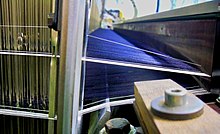
In 2016, Mönchengladbach achieved a gross domestic product of € 8.710 billion within the city limits, making it 39th in the ranking of German cities by economic output . The GDP per capita in the same year was € 33,442 (North Rhine-Westphalia: € 37,416, Germany € 38,180). In 2016 there were around 133,300 gainfully employed people in the city. The unemployment rate in December 2018 was 8.8% and thus above the average of 6.4% for the state of North Rhine-Westphalia. At that time, 12,279 people were registered as unemployed, 2,024 fewer than in December 2017 - a decrease of 14.2%. The average unemployment rate in Mönchengladbach was 9.8% in 2018.
Mönchengladbach's industrial rise was mainly shaped by the development of the textile industry from the middle of the 19th to the middle of the 20th century. In addition, a textile-oriented machine industry developed.
After the Second World War, a comprehensive structural change began, during which the importance of the textile industry decreased and new branches of the economy gained in importance. Currently, only 7 percent of the workforce is employed in the once dominant textile and clothing industry ( e.g. Van Laack and gardeur ). As part of the successful diversification of the business location, the city and representatives of the local companies founded the Mönchengladbach Economic Development Corporation (WFMG) in 1997. Together with the Niederrhein University of Applied Sciences, the WFMG has developed a five-pillar model for the future direction of the business location. According to this, textiles and fashion, mechanical engineering and electrical engineering, logistics, the creative industries and health care are key sectors that determine the economic future of the city of Mönchengladbach. As part of an active cluster policy , the WFMG has in part initiated its own networks for these industries.
Since the 2000s, numerous well-known companies such as Zalando , Esprit , Adidas , L'Oréal , DHL , C&A , Primark and Amazon have settled in Mönchengladbach's industrial areas. The Regiopark logistics location, together with the neighboring one in Güdderath, is the largest industrial park in Mönchengladbach. On the 165 hectare Nordpark, a former military conversion area , there are not only Borussia-Park and Hockeypark but also companies from the creative, digital and other sectors. The Santander Consumer Bank, for example, has one of its offices there; the German headquarters is in the city center. The fashion company Van Laack is also based in Nordpark, as are Eizo and Ricoh , for example . Other companies based in Mönchengladbach include the beverage companies Valensina , Refresco , Oettinger Brewery and the logistician Vanderlande . Coca-Cola has had one of its largest production and filling lines in Europe there since a capacity expansion in 2018.
The products of the city's economic structure include machine tools and spinning machines ( Dörries Scharmann , Monforts , Trützschler , Schlafhorst ), automatic conveyor systems, signal and system technology ( Scheidt & Bachmann ), transformers ( SMS Meer ), cables ( Nexans Germany, formerly Kabelwerk Rheydt), printed matter as well as food and beverages.
Chocolatier Heinemann is known beyond the city limits for its cakes, pralines and baked goods. There are also beer breweries in Mönchengladbach. The Oettinger brewery produces at the location of the former Hannen brewery . The Hensen brewery has been producing a typical Lower Rhine Altbier at the former source of the Gladbach in the Waldhausen district since 2015 . The Hausbrauerei Zum Stefanus in the Rheindahlen district of Mennrath serves not only a light and dark full beer, but also other seasonal beers.
In 2016, the Mönchengladbach City Council adopted the mg + Growing City urban development strategy . The leitmotifs of the strategy are living space, environment, economy and location factors. The goals are to improve living conditions and to strengthen the business location. The strategy is to be implemented in various projects.
Employment and unemployment
Statistical key figures for Mönchengladbach:
| Employees 1) | 82,406 | |
| Number of unemployed 2) | 15,287 | 11.5% |
| - of which men | 7,935 | 51.9% |
| - of which women | 7,352 | 48.1% |
| - including Germans | 12,037 | 78.7% |
| - of which foreigners | 3,250 | 21.3% |
| - of which under 20 years | 425 | 2.8% |
| - of which 20 to 55 years | 12,500 | 81.8% |
| - of which 56 years and older | 2,362 | 15.5% |
1) Employment statistics as of June 30, 2012
2) Unemployment statistics as of August 31, 2014
traffic
railroad
The two main train stations Mönchengladbach and Rheydt are on the main lines from Cologne to Venlo , Duisburg – Mönchengladbach and Aachen – Düsseldorf . Mönchengladbach Hbf also has a S-Bahn connection to Düsseldorf and Wuppertal (line S 8). There are other train stations in Odenkirchen , Wickrath and Rheindahlen , and the Herrath and Lürrip ( S-Bahn ) and Genhausen ( RB ) stops are in the urban area.
In long-distance traffic operated by Deutsche Bahn AG, Mönchengladbach Hauptbahnhof is served once a day by Intercity to and from Berlin, Monday to Friday . There is also an ICE on Fridays . The ICE International from Amsterdam to Frankfurt (Main) also stops here for major construction work in the rail network .
The Maas-Wupper-Express from Hamm / Westf enables an hourly connection to the neighboring Netherlands . to Venlo (NL). Crossing the border behind Kaldenkirchen is considered a journey within the network and VRR tickets are recognized. Venlo with the old town and the banks of the Maas is a popular destination, especially on German public holidays. You can also easily switch to the train to Amsterdam Bijlmer Arena and Schiphol Airport.
The Iron Rhine , a freight train route to the Belgian seaports, was run via Dalheim and Roermond (NL) until 1992 .
Transportation
In addition to the subway lines in to public transport (public transport), the bus lines of the NEW mobile and active Mönchengladbach operated. All lines are to be used at uniform prices within the Verkehrsverbund Rhein-Ruhr (VRR). On the weekends and on the nights before public holidays, night buses run every hour until 3.15 a.m. as night express from the city centers of Mönchengladbach and Rheydt to the neighboring districts.
The beginning of public transport marked the opening of the horse-drawn tram between Gladbach and Rheydt in 1881, which was operated jointly by both cities. In 1900 the switch to electrical operation took place, in 1901 this was divided between the two cities. The Mönchengladbach tram ran until 1969, the Rheydt tram was discontinued in 1959. The Rheydt trolleybus also operated in Rheydt from 1952 to 1973 .
air traffic
The Mönchengladbach airfield is mainly used by private and commercial general aviation . There is currently no scheduled service. Not far from Mönchengladbach is Düsseldorf International Airport , which was the majority shareholder of Mönchengladbach Airport from 1996 to 2018 and has held a 20% stake since 2018. The development company of the City of Mönchengladbach (EWMG) has been the majority shareholder with 54.75% since 2018. NEW mobil und aktiv Mönchengladbach (25.24%) and the city of Willich (0.01%) hold further shares . Due to the runway of 1200 m, which is too short for air traffic with larger jets , there were expansion plans to enable scheduled flight operations again. In the planning approval procedure required for this at the Düsseldorf District Government, there was no majority in the Düsseldorf Regional Council for an extension of the runway. The Düsseldorf airport company then no longer pursued the expansion plans.
Streets
With the automotive the city via which motorways A 44 ( Aachen - Kassel ,) A 46 ( Hein Berg - Bestwig ) and A 52 ( Roermond - food - Marl ) and A 61 ( Venlo - Hockenheim ) to reach. The Mönchengladbach interchange is in the northeast and the Mönchengladbach-Wanlo interchange is in the southeast of the city. Furthermore, the federal highways B 57 , B 59 and B 230 run through the city area. The distances to the surrounding larger cities are 30 kilometers to Düsseldorf , 35 kilometers to Duisburg , 20 kilometers to Krefeld , 60 kilometers to Cologne, 60 kilometers to Aachen, 35 kilometers to Venlo in the Netherlands and 35 kilometers to Roermond, also in the Netherlands Kilometre.
Bicycle traffic
Mönchengladbach is on the Euroga cycle route . The mostly flat Lower Rhine landscape offers many opportunities for leisure tours, for example along the Niers and on the Lower Rhine route . Signposted routes on the NRW cycling network also exist in the neighboring districts of Viersen , Neuss and Heinsberg as well as to Düsseldorf and Krefeld . The expansion of the inner-city cycle path network has been the subject of political discussions in the past. In September 2017, the city's first cycle route - the Blue Route - opened; it connects the campus of the Niederrhein University of Applied Sciences with the main train stations in Gladbach and Rheydt.
At the main station Rheydt and at Mönchengladbach Hauptbahnhof are modern bicycle stations , which allow parking bicycles combined with other services.
media
The local radio station Radio 90.1 Mönchengladbach is located on Lüpertzender Straße . It went on the air on September 29, 1990, on October 30, 1990, the first broadcast was broadcast as part of the community radio on the frequencies of the station.
Since January 19, 2009, the regional television broadcaster CityVision has been broadcasting news from Mönchengladbach and the surrounding area on the S18 cable channel daily from 4:00 p.m. to midnight. The year before, it began broadcasting on public screens, for example on the Alter Markt, in hospitals and / or in fitness studios.
Mönchengladbach does not publish its own daily newspaper . The Rheinische Post and the Westdeutsche Zeitung report on local and regional events as well as two free, advertising-financed newspapers that are distributed to all households once a week (the Stadtspiegel on Wednesdays and the Extra-Tipp on Sundays on Sundays ). The Hindenburger is a city magazine about lifestyle, culture, leisure and gastronomy, which appears free of charge every month and is distributed as a display in shops. The GURU magazine with a focus on society and lifestyle is distributed directly to households. Since 1997 there has been a local edition of the street newspaper Fiftyfifty , which is sold by people in social need and is run by the Diakonisches Werk Mönchengladbach e. V. is published.
In the online citizens' newspaper Mönchengladbach , which has existed since December 2007, citizens can publish their own articles under the Creative Commons , the main topic being local politics. Local politicians use this medium.
Moenchengladbach Also one was medium-wave transmitter of the AFN , who worked on 1143 kHz with 1 kW output power. He used a 45.5 meter high transmitter mast at 51 ° 10 ′ 2 ″ N , 6 ° 23 ′ 56 ″ E as a transmitting antenna .
Public facilities
- Police headquarters Mönchengladbach, Krefelder Strasse
- Local and regional court Mönchengladbach , Hohenzollernstrasse
- Labor Court Mönchengladbach , Hohenzollernstrasse
- Mönchengladbach-Rheydt District Court , Brucknerallee
- Mönchengladbach tax office , Am Hockeypark
- Mönchengladbach customs office , Dohrweg
- Straßen.NRW , Landesbetrieb Straßenbau NRW, regional branch Niederrhein, Breitenbachstraße
Education and Research
school
In Mönchengladbach the entire spectrum of general and vocational schools can be found in public and private sponsorship. The city has a total of 95 schools, from elementary schools to universities, including a Waldorf school.
education and study
The Niederrhein University of Applied Sciences was founded in 1971 through the merger of twelve technical and engineering schools in several cities . The administration is located in Krefeld. On the Mönchengladbach campus, the departments of nutrition, social affairs, textile and clothing technology and economics research and teach. The course is designed in a practical way with close contacts to the regional economy and leads to degrees with a bachelor's or master's degree. There has also been a doctoral college since 2012.
The textile campus on Webschulstrasse deserves special mention. In addition to the Niederrhein University of Applied Sciences, the Fraunhofer-Gesellschaft's research center for textile logistics and, since 2018, the Textile Academy NRW for training and further education in commercial and technical professions with a focus on the textile and clothing industry are located there.
The medicoreha Welsink Academy , with its state-approved technical schools for physiotherapy and occupational therapy , conducts practical training for 450 trainees in the Maria Hilf clinics.
The music school of the city of Mönchengladbach offers musical training for children through to preparation for the entrance examination at a music college. More than 4,000 students take advantage of the offers.
library
The Mönchengladbach City Library was opened in 1905 and offers general literature for children and adults as well as media in foreign languages. The historical collection includes the International Ex-libris Center Mönchengladbach, the former library of the Cologne Franciscan Order Province with works from the 16th to the early 19th centuries from the fields of science and wisdom, and the former library of the former Volksverein for Catholic Germany (1892– 1933) on social and economic science. She was one of the participants in the location initiative Germany - Land of Ideas of the Federal Government and the Federation of German Industry.
sport and freetime
American football
The MG-Wolfpack currently plays in the Oberliga NRW. The football department is part of American Sports Mönchengladbach e. V.
billiards
The 1st PBC Neuwerk was promoted to the 1st Pool Billiards Bundesliga in the 2014/15 season. Since the 2016/17 season the club has been playing in the 2nd Bundesliga again . In 2014, Sascha Jülichmanns also became a Mönchengladbach German champion .
Archery
The Rheydter Turnverein 1847 e. V. with its archery department is Mönchengladbach's most successful archery club . He has one team each in the 1st Bundesliga North and in the Regionalliga West. In 2008 the Bundesliga team made it to the Bundesliga finals for the first time in the club's history.
Soccer

Mönchengladbach's largest, most famous and most successful football club is Borussia Mönchengladbach . The traditional club celebrated five German championships and two UEFA Cup victories in the 1970s . The club plays in the Bundesliga and plays its home games in Borussia-Park . Borussia's U-23 team plays in the regional league and usually plays their home games in the Grenzlandstadion . The oldest football club in the city is 1. FC Mönchengladbach . This club was the youth club of Günter Netzer , who moved from there to Borussia Mönchengladbach. The club was founded in 1894 and currently plays in the national league. It is also the oldest football club in the West German Football Association .
Handball
Numerous clubs with junior and senior teams are represented in the city. The currently top-class team is the 1st team (men) of the handball department of Borussia Mönchengladbach, which is active in the Oberliga Niederrhein. Home games are played in the Jahnhalle. Several teams from the city are also represented in the association league (women: Rheydter TV 1847, Welfia Mönchengladbach, Turnerschaft Lürrip; men: TV Einigkeit Geistenbeck).
hockey
Mönchengladbach is the seat of the German Hockey Federation . The Gladbacher HTC plays in the field hockey Bundesliga . The Rheydter SV plays in the second field hockey Bundesliga . The Gladbacher HTC became German champions in 2002 and plays the home games on the club's own facility or in the hockey park . The men's field hockey world championship 2006 took place there from September 6th to 17th . Rheydter SV is the oldest hockey club in Mönchengladbach, in 2001 it was the last German cup winner to date. He plays his games on his own artificial turf field at the Grenzland Stadium. The RSV was promoted to the 1st Bundesliga at the end of the 2008/09 season.
Judo
The 1st Judo Club Mönchengladbach is currently the strongest judo club on the Lower Rhine. The women's team has been fighting in the 1st Bundesliga since 2000, the men's team was promoted to the 1st Bundesliga in 2008. The best-known judoka of the 450-member club is the three-time Olympian and bronze medalist in 2012, Andreas Tölzer .
Harness racing
On the Mönchengladbach trotting track , which opened in 1893 , the Association for the Promotion of Rheinische Trabrennsportes e. V. (until the end of 2007 trotting club Mönchengladbach eV ) regular trotting races . In September 2019 it was announced that the development company of the city of Mönchengladbach intends to terminate the lease for the trotting track in favor of the settlement of other flight-related businesses at the airport at the end of 2021.
Culture and sights
Theater and music
The United City Theaters of Krefeld and Mönchengladbach offer operas, operettas, musicals, drama and ballet in the theaters of both cities. The cooperation theater was founded in 1950. The orchestra accompanying the stages is the "Niederrheinische Sinfoniker", who also give symphony concerts.
There is also the BIS in the former museum on Bismarckstrasse, a center for all kinds of culture, including painting, jazz and contemporary music, Die Spindel , a cabaret in Don Antonio (Haus Ohlenforst), “The Red Crocodile”, a cabaret in the Wickrath district, the cabaret "Theater im Gründungshaus" in the Eicken district and the "Theater Playground", Mönchengladbach's smallest stage. It offers cabaret, theater and literature and is located in Rheydt.
The Music Community MG was a loose association of organizers and cultural sponsors in cooperation with the Department of Further Education and Music of the City of Mönchengladbach (as of 2015). Every year artists from the field of popular music are promoted at ten events. With the two-day music festivals citymovement indoor (2006) and citymovement outdoor (2007), the MG MusicCommunity has resumed the tradition of the largest free-and-outside festival in the region. Another new beginning of the free and outdoor festival at Platz der Republik took place from 2009 to 2014 under the name Horst Festival , which was organized by the AStA of the Niederrhein University of Applied Sciences .
The Ensemblia music festival, founded in 1979, is held every two years in Mönchengladbach. In addition, various events under the Econore - label instead.
Mönchengladbach music groups with international success were the Krautrock band Wallenstein in the 1970s and the rock band Sun in the early to mid-1990s . Between 1985 and 1991 the jazz-rock-pop band Newtation was regionally successful. EA80 (one of the oldest German punk bands), the hard rock band Motorjesus and the rapper Eko Fresh are known nationwide .
Museums
See also: List of museums in Mönchengladbach
- Museum Abteiberg : Museum for fine arts of the 20th and 21st centuries. With works by Joseph Beuys, Sonia Delaunay-Terk, Richard Serra, Andy Warhol, Sigmar Polke, Gerhard Richter, Martin Kippenberger, the ZERO group, Donald Judd, Jonathan Meese and others.
- Rheydt Castle : Collection of art and cultural objects from the Renaissance and Baroque periods as well as Mönchengladbach's textile history
- Archaeological Museum Rheindahlen: Stone Age sites of the Lower Rhine
- Carnival Museum Altes Zeughaus
- Ornithological Museum Schloss Wickrath : Exhibition collection of Rhenish bird species and other native animals
- Movie characters exhibition: collection of movie characters, dioramas, movie props, Lego models and costumes
- MMIII Art Association Mönchengladbach e. V.
Stumbling blocks
On January 27, 2006 Gunter Demnig laid the first three Stolpersteine in Mönchengladbach in the Odenkirchen district . By November 2013 there were 241 in 69 locations in the entire city area.
Buildings
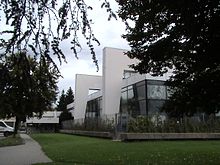
- 10th century Neuwerk (Mönchengladbach) Monastery , Mönchengladbach-Neuwerk, built
- 11th century: Catholic parish church of St. Helena, Mönchengladbach-Rheindahlen
- Early 12th century: (crypt) of St. Vitus Minster , Mönchengladbach-Stadtmitte, 1228–1239 (nave) and 1256–1277 (choir, designed by Master Gerhard )
- Early 15th century: Dicker Turm, Mönchengladbach-Stadtmitte, part of the medieval city fortifications, today the district archive of the brotherhoods
- 1469–1533: Catholic parish church St. Mariä Himmelfahrt , Mönchengladbach-Stadtmitte, reconstruction after the Second World War
- 1558–1570: Rheydt Castle , Mönchengladbach-Rheydt, mansion built, designed by Maximilian Pasqualini , conversion into Joseph Goebbels' guest house by Emil Fahrenkamp during the Nazi era, today a museum
- Early 17th century: St. Vith, Mönchengladbach-Stadtmitte, former guest house of the abbey, today a restaurant
- 17th century: Huppertzhof, Mönchengladbach-Uedding, courtyard, today residence and studio of the well-known sculptor Heinz Mack
- 1663–1705: City Hall Abbey (originally Benedictine monastery), Mönchengladbach city center, reconstruction in 1950
- 1734: Gatehouse of Odenkirchen Castle , Mönchengladbach-Odenkirchen
- 1746–1772: Wickrath Castle , Mönchengladbach-Wickrath, built by the builders Francois and Matthieu Soiron
- 1755–1757: Evangelical parish church, Mönchengladbach-Odenkirchen, designed by Francois Soiron
- 18th century: Hensen brewery, Mönchengladbach-Waldhausen
- 18th century: Schriefersmühle, Mönchengladbach-Rheindahlen, formerly a windmill
- 18th century: House Zoppenbroich , Mönchengladbach-Rheydt as a moated castle
- End of the 18th century: Abtshof, Mönchengladbach-Neuwerk, today a restaurant and equestrian area
- 1853–1855: Catholic parish church St. Marien, Mönchengladbach-Rheydt, designed by Vincenz Statz , reconstruction and conversion by Alfons Leitl after the Second World War
- 1855: Gladbach stock spinning and weaving mill, an "industrial castle", today part of the vocational college for technology and media at the Platz der Republik
- 1864–1866: Evangelical Peace Church (today residential building), Mönchengladbach-Rheydt-Geneicken, designed by Maximilian Nohl
- 1889–1891: Catholic parish church St. Laurentius, Mönchengladbach-Odenkirchen, designed by Franz Schmitz
- 1894–1896: Rheydt Town Hall , Mönchengladbach-Rheydt, based on a design by Robert Neuhaus
- 1896: Catholic Brandt Chapel St. Aloysius, Mönchengladbach-Waldhausen, inaugurated in 1896, built by Franz Brandts , designed by a former government builder . D. Anton Peter New
- 1899–1902: Main Protestant Church in Rheydt , Mönchengladbach-Rheydt, based on a design by Johannes Otzen
- 1902–1903: Kaiser-Friedrich-Halle , Mönchengladbach-Stadtmitte, designed by Friedrich W. Werz and Paul Huber , burnt out and restored several times
- 1903–1904: Hardterwald Clinic, Mönchengladbach-Hardt, a donation to the city from Louise Gueury
- 1903–1905: Catholic parish church St. Josef, Mönchengladbach-Rheydt, designed by Josef Kleesattel
- 1906: Catholic St. Bonifatius Church
- 1907–1909: Water tower on Viersener Strasse , Mönchengladbach-Stadtmitte, based on a design by Otto Greiß (1876–1945)
- 1926–1928: St. Kamillus Asthma Hospital with church and monastery, Mönchengladbach-Dahl, designed by Dominikus Böhm
- 1928–1930: Rheydt town hall, Mönchengladbach-Rheydt, designed by Walter Fischer , Hans Poelzig and Max Littmann , remodeling 1982–1984, designed by HPP
- 1930: St. Franziskus parish church, Mönchengladbach-Rheydt-Geneicken, designed by Dominikus Böhm
- 1933: Parish Church of St. Peter, Mönchengladbach-Waldhausen, designed by Clemens Holzmeister
- 1933–1935: Catholic parish church St. Elisabeth, Mönchengladbach-Eicken, designed by Herrmann Schagen
- 1938–1955: Vocational school, Mönchengladbach-Rheydt-Mülfort, designed by Emil Fahrenkamp
- 1957–1959: Schauspielhaus, Mönchengladbach-Stadtmitte, demolished in 2012, designed by Paul Stohrer
- 1969: Pahlkebad, Mönchengladbach-Rheydt, named after Emil Pahlke (1889–1893 Lord Mayor of Rheydt), closed since January 2008 due to the need for renovation, since April 2008 a listed building; the reopening of the renovated swimming pool took place on March 31, 2012.
- 1972–1982: Abteiberg Museum , Mönchengladbach-Stadtmitte, based on a design by Hans Hollein
- 2002–2004: Borussia-Park in Nordpark , designed by planning group B
- 2005: Hockey Park
- 2015: Hugo Junkers hangar with vintage aircraft JU 52
- 2015: Minto
- Evangelical parish church, Mönchengladbach-Wickrathberg
- Nonnenmühle, Mönchengladbach-Lürrip, former mill
- Vitusbad in City East after the former central bath was destroyed by a major fire on July 23, 2001
- Volksbad in the Volksgarten
- Haus Horst moated castle , Mönchengladbach-Giesenkirchen, largely renovated in 1853
Parks in Mönchengladbach
- Colorful garden with botanical garden
- Abbey garden
- Volksgarten Mönchengladbach
- Wickrath Castle Park
- Zoppenbroicher Park (also called Bresgespark)
- Geropark
- Vitus Park
- Dahler leisure park
- Schmölderpark
- Rheydt city forest
- Hans-Jonas-Park (formerly Berggarten)
- Beller Park in Odenkirchen
- Niersgrünzug
- Hugo Junkers Park
- Helga-Stöver-Park
Other sights
Regular events
- February / March: Town hall storm in Rheydt on Rose Monday and violet Tuesday procession
- April: annual consumer exhibition Mönchengladbach, Kappesfest (craft market) in Rheindahlen
- May: Ensemblia (two-year cycle)
- Spring / Summer: Nocturnal - cultural event with numerous events spread over the entire city area
- Summer: choir and orchestra concerts in the concert shell in the colorful garden
- June: Tower Festival in Rheydt
- Five continents world music festival (every two years)
- July: "One City Festival", a festival at the lake in Wickrath
- August: Summer music at Rheydt Castle, open air concert series with classical, jazz, swing and pop music.
- September: Automobile exhibition, Rheydter Flower Week with awarding of the Rheydt Golden Flower every two years, street jazz festival,
- Stadtschützenfest district association Mönchengladbach-Rheydt-Korschenbroich in the Federation of the Historical German Rifle Brotherhoods
- October: Jazz in the church (two-year rhythm)
- November: Nocturnal activity - Mönchengladbach Culture Night (every two years)
- December: Christmas market
- Jewish Culture Days in the Rhineland Participation in all projects (2002; March 2007)
climate
Climatically , Mönchengladbach is characterized by a favorable location that is influenced by the North Sea and the Gulf Stream . Winters are poor in snow and spring sets in quite early. The annual average rainfall is around 801 mm. The annual mean temperature is approx. 11.6 ° C.
| Mönchengladbach | ||||||||||||||||||||||||||||||||||||||||||||||||
|---|---|---|---|---|---|---|---|---|---|---|---|---|---|---|---|---|---|---|---|---|---|---|---|---|---|---|---|---|---|---|---|---|---|---|---|---|---|---|---|---|---|---|---|---|---|---|---|---|
| Climate diagram | ||||||||||||||||||||||||||||||||||||||||||||||||
| ||||||||||||||||||||||||||||||||||||||||||||||||
|
Average monthly temperatures and rainfall for Mönchengladbach
Source: DWD, data: 2015–2020
|
||||||||||||||||||||||||||||||||||||||||||||||||||||||||||||||||||||||||||||||||||||||||||||||||||||||||||||||||||||||||
License Plate
On July 1, 1956, the MG license plate was introduced. It is issued continuously to this day. The former license plate RY (City of Rheydt) has not yet been reintroduced.
Personalities
Some of the personalities born in Mönchengladbach have gained national or international fame, and in some cases also gained recognition. The most important internationally are probably the engineer Hugo Junkers , the philosopher Hans Jonas , the former Formula 1 drivers Nick Heidfeld and Heinz-Harald Frentzen as well as the soccer players Jupp Heynckes and Günter Netzer . Joseph Goebbels , the Minister for Propaganda and Public Enlightenment during the National Socialist era, was born in Rheydt. Nationally known personalities include the former Prime Minister of North Rhine-Westphalia, Franz Meyers , the animal filmmaker Heinz Sielmann , the cabaret artist Volker Pispers , the author Walter Moers , the science astronaut Reinhold Ewald , the opera singer Hermin Esser , the comedian Monty Arnold and the virtuoso guitarist Joscho Stephan . The TV presenter Joko Winterscheidt from Mönchengladbach is also there.
literature
- Ernst Brasse: History of the city and Abbey of Gladbach and documents and regesta on the history of the city and Abbey of Gladbach . Unchanged reprint of the edition by M. Gladbach 1914–1926. Antiquarian bookshop at St. Vith, Mönchengladbach.
- Robert Lünendonk: On the trail of the Gladbach and its mills. Contributions to the history of the city of Mönchengladbach . Klartext Verlag, Essen 2008, ISBN 978-3-8375-0030-1 .
- Peter Norrenberg : History of the parishes of the deanery M. Gladbach . Unchanged reprint. Antiquariat am St. Vith, Mönchengladbach, 2005, Cologne 1889.
- Doris Schilly: Right among us. Jewish life in Mönchengladbach . Sutton Verlag, Erfurt 2006, ISBN 978-3-89702-984-2 .
- Heinrich Silbergleit: Prussian cities - memorandum for the 100th anniversary of the city ordinance of November 19, 1808 . Edited on behalf of the board of the Prussian City Council, Berlin 1908.
- Erich Keyser: Rheinisches Städtebuch . Ed .: Working group of historical commissions and with the support of the German Association of Cities, the German Association of Cities and the German Association of Municipalities. Volume III 3rd volume from “German City Book. Handbook of Urban History ”. Stuttgart 1956.
- Rudolph Wiedemann: History of the former. Lordship and the House of Odenkirchen . Reprinted with a foreword by Norbert Bude. Antiquariat am St. Vith, 2008, Odenkirchen 1879.
- Laurentius messenger . Odenkirchen.
- Wolfgang Löhr with the support of the Sparkasse Foundation for Art and Science, the Reiners Foundation GmbH and the Josef and Hilde Wilberz Foundation (ed.): Loca Desiderata, Mönchengladbacher Stadtgeschichte . tape 1 . Rhineland publishing and operating company of the Rhineland Regional Association, Brauweiler Abbey, Pulheim 1994, ISBN 3-7927-1375-6 .
- Wolfgang Löhr with the support of the Sparkasse Foundation for Art and Science, the Reiners Foundation GmbH and the Josef and Hilde Wilberz Foundation (ed.): Loca Desiderata, Mönchengladbacher Stadtgeschichte . tape 2 . Rhineland publishing and operating company of the Rhineland Regional Association, Brauweiler Abbey, Pulheim 1999, ISBN 3-7927-1801-4 .
- Wolfgang Löhr with the support of the Sparkasse Foundation for Art and Science, the Reiners Foundation GmbH and the Josef and Hilde Wilberz Foundation (ed.): Loca Desiderata, Mönchengladbacher Stadtgeschichte . tape 3.1 . Rhineland publishing and operating company of the Rhineland Regional Association, Brauweiler Abbey, Pulheim 2003, ISBN 3-7927-1883-9 .
- Wolfgang Löhr with the support of the Sparkasse Foundation for Art and Science, the Reiners Foundation GmbH and the Josef and Hilde Wilberz Foundation (ed.): Loca Desiderata, Mönchengladbacher Stadtgeschichte . tape 3.2 . Rhineland publishing and operating company of the Rhineland Regional Association, Brauweiler Abbey, Pulheim 2003, ISBN 3-87448-265-0 .
- Margit Sollbach-Papeler (ed.): Mönchengladbach and Rheydt 1939–1945: Everyday life under bombs . Bookmark Verlag, Hagen 1997, ISBN 3-930217-17-1 .
- Christoph Nohn: Prelude to Gladbach's history. The founding history of Gladbach Abbey and the political tension in Lotharingia in the 9th and 10th centuries . Klartext Verlagsgesellschaft mbH, Essen 2011, ISBN 3-8375-0510-3 .
- Robert Lünendonk: The Niers and their mills . From the source to Neuwerk. Ed .: Christian Wolfsberger. 1st edition. Klartext Medienwerkstatt GmbH, Essen, Mönchengladbach 2012, ISBN 978-3-8375-0741-6 .
- Rüdiger Pongs: The Gladbach city fortifications . The defenses in Gladbach from the fortified Münsterberg to the fortification of the Thirty Years War. Ed .: Christian Wolfsberger. Klartext Medienwerkstatt GmbH, Essen, Mönchengladbach 2014, ISBN 978-3-8375-1101-7 ( limited preview in the Google book search).
- Illustrated books
- Christian Wolfsberger, Ilona Gerhards: Mönchengladbach as it was . Droste Verlag GmbH, Düsseldorf 2010, ISBN 978-3-7700-1384-5 .
Web links
- Literature by and about Mönchengladbach in the catalog of the German National Library
- Link catalog on Mönchengladbach at curlie.org (formerly DMOZ )
- Official website of the city . City of Mönchengladbach / The Lord Mayor. Retrieved May 17, 2017.
- Käthe Limburg, Bernd Limburg: Monuments in the city of Mönchengladbach. In: on the way & at home - homepage of Käthe and Bernd Limburg. July 18, 2011, accessed June 2, 2012 .
Individual evidence
- ↑ Population of the municipalities of North Rhine-Westphalia on December 31, 2019 - update of the population based on the census of May 9, 2011. State Office for Information and Technology North Rhine-Westphalia (IT.NRW), accessed on June 17, 2020 . ( Help on this )
- ^ Federal Statistical Office (ed.): Historical municipality directory for the Federal Republic of Germany. Name, border and key number changes in municipalities, counties and administrative districts from May 27, 1970 to December 31, 1982 . W. Kohlhammer, Stuttgart / Mainz 1983, ISBN 3-17-003263-1 , p. 291 .
- ↑ Population of the municipalities of North Rhine-Westphalia on December 31, 2019 - update of the population based on the census of May 9, 2011. State Office for Information and Technology North Rhine-Westphalia (IT.NRW), accessed on June 17, 2020 . ( Help on this )
- ↑ http://www.derwesten.de/region/das-ende-von-kettwig-wattenscheid-und-rheydt-id10244922.html Report in the daily Westdeutsche Allgemeine Zeitung (WAZ) from January 18, 2015
- ↑ City of Mönchengladbach (ed.): Statistisches Handbuch Mönchengladbach 2010–2014 . December 2015, IX. Geographical information, weather conditions and land registry area , p. 62 ( presse-service.de [PDF; 6.3 MB ; accessed on September 13, 2018]).
- ↑ BürgerZeitung MG, May 9, 2012: Interview
- ↑ Dieter Weber: Four districts in the local elections. In: RP Online. January 23, 2009. Retrieved April 19, 2019 .
- ↑ a b c Statistical key figures of the Düsseldorf district government for Mönchengladbach, accessed on March 1, 2015
- ↑ a b First Beginnings ( Memento from July 4, 2014 in the Internet Archive ) on moenchengladbach.de, accessed on July 16, 2014
- ^ Wolfgang Löhr: Loca Desiderata: Mönchengladbach city history. Volume 1 . Rheinland-Verlag- und Betriebsgesellschaft des Landschaftsverband Rheinland, Abtei Brauweiler, 50259 Pulheim 1994, ISBN 3-7927-1375-6 , p. 139
- ^ Christian Lingen: Spectacular finds at Rheydt Palace . Retrieved November 8, 2011.
- ^ Wolfgang Löhr: Loca Desiderata: Mönchengladbach city history. Volume 1 . Rheinland-Verlag- und Betriebsgesellschaft des Landschaftsverband Rheinland, Abtei Brauweiler, 50259 Pulheim 1994, ISBN 3-7927-1375-6 , p. 157
- ↑ Kurt Baltus: The Mairien in the Département de la Roër in the years 1806, 1808 and 1813. (PDF; 20 kB) West German Society for Family Studies , September 11, 2012, p. 3 , accessed on April 19, 2019 .
- ↑ Mönchengladbach City Archives 1c / 3608
- ^ Walter Grabmann (1957): History of German Air Defense 1933-1945 , Study for the US Air Force (Part I, p. 285)
- ↑ z. B. wrote Jörg Friedrich in his book Der Brand (2004, p. 77) “Prelude” to the bombing war on German soil.
- ^ Rheinische Post : How the war made Mönchengladbach a city of ruins .
- ↑ 41. Evacuation Hospital
- ^ Heinz-Josef Katz: POW camp . Retrieved November 12, 2011.
- ↑ Mönchengladbach Religion , 2011 census
- ↑ Statistics 2019 , accessed on July 9, 2020
- ↑ Development of the population in Mönchengladbach (independent city) from 1995 to 2017 at Statista
- ↑ Lea Hensen, Dieter Weber: Churches react to the exit trend. In: RP Online. July 31, 2018, accessed September 4, 2019 .
- ↑ William Niepoth: Monchengladbach (North Rhine-Westphalia, Germany) . In: Global Anabaptist Mennonite Encyclopedia Online
- ^ Wolfgang Löhr: Mennonites in Mönchengladbach . In: Mennonite history sheets . tape 57 . Weierhof (Palatinate) 2000, p. 89 ff .
- ↑ Effects of the Reformation. (No longer available online.) In: moenchengladbach.de. City of Mönchengladbach, archived from the original on June 11, 2011 ; Retrieved August 6, 2011 .
- ^ Church in the Mönchengladbach region. Accessed March 28, 2018 (English).
- ↑ Klaus Ulrich Ruof: Former Methodist Church becomes Alevi Cemhaus. Methodist Church, June 18, 2012, accessed February 17, 2019 .
- ↑ locations. In: christadelphian.de. Christadelphian Congregation, accessed April 19, 2019 .
- ↑ Homepage
- ↑ Invitation to paradise: How the Salafists failed in Mönchengladbach - Jörg Lau . In: Jörg Lau . October 13, 2011 ( zeit.de [accessed on March 28, 2018]).
- ↑ Martin Bünermann, Heinz Köstering: The communities and districts after the municipal territorial reform in North Rhine-Westphalia . Deutscher Gemeindeverlag, Cologne 1975, ISBN 3-555-30092-X .
- ^ Population in North Rhine-Westphalia. In: it.nrw. State Office for Information and Technology North Rhine-Westphalia, December 4, 2018, accessed on April 19, 2019 .
- ↑ Results of the local elections from 1946 to 2004 . Ministry of the Interior of North Rhine-Westphalia. Retrieved September 3, 2009.
- ^ Ralf Jüngermann: The CDU is looking for new friends . Opposition was yesterday, the Christian Democrats can shape things again. At least in theory. In fact, as the strongest parliamentary group, they are called upon to search for majorities in the Council with immediate effect. In fact, the options are few. In: Rheinische Post . Mönchengladbach City Post Office. No. 91 . Rheinische Post Verlagsgesellschaft mbH, Mönchengladbach April 19, 2013, p. C 2 .
- ↑ Results of the council elections of May 25, 2014 , Kommunaler Zweckverband ITK Rheinland, May 27, 2014, accessed on April 19, 2019
- ↑ Council Group . SPD subdistrict Mönchengladbach
- ↑ Numbers, data, facts. City of Mönchengladbach, accessed on July 5, 2020 .
- ↑ Overview of the twin cities of the city of Mönchengladbach. In: moenchengladbach.de. City of Mönchengladbach, accessed on April 19, 2019 .
- ↑ Current results - VGR dL. Retrieved January 7, 2019 .
- ^ Federal State of North Rhine-Westphalia. Labor market statistics by region. Federal Employment Agency, accessed on January 7, 2019 .
- ↑ An overview of the labor market - reporting month December 2018 - Mönchengladbach, Stadt. Federal Employment Agency, accessed on January 17, 2019 .
- ↑ Article from October 15, 2018
- ^ Kempen: The intermunicipal economic derby. In: Rheinische Post . Retrieved June 13, 2018 .
- ↑ Mönchengladbach: At Hensen something is brewing again. In: Rheinische Post . Retrieved June 16, 2018 .
- ↑ Zum Stefanus - Mönchengladbach's only private brewery . Eva Zimmermann, Karoline Kneist. August 11, 2017. Retrieved June 17, 2018.
- ↑ A strategy book for the future of the city. In: Focus Online . June 28, 2018, accessed January 17, 2019 .
- ↑ Questions about trips to other networks. Verkehrsverbund Rhein-Ruhr, accessed on July 5, 2018 .
- ^ NS International. Retrieved July 5, 2018 .
- ↑ Reach your destination quickly and safely. The six lines from NACHTEXPRESS (PDF) NEW mobile and active Mönchengladbach. Retrieved May 19, 2018.
- ↑ EWMG takes over majority at Mönchengladbach Airport. In: ewmg.de. EWMG - Development Company of the City of Mönchengladbach, 2018, accessed on February 11, 2019 .
- ^ Ralf Jüngermann: The end of the airport. (No longer available online.) In: RP Online . December 18, 2009, archived from the original on February 2, 2017 ; Retrieved March 2, 2010 .
- ↑ City wants to expand cycle path network . Rheinische Post Online. Retrieved August 27, 2011.
- ↑ Blue Route - Mönchengladbach . City of Mönchengladbach. Retrieved May 19, 2018.
- ↑ Textilakademie NRW - Berufskolleg gGmbH (ed.): Textilakademie NRW - Brief description January 2018 . Mönchengladbach January 2018.
- ↑ Andreas Gruhn: Mönchengladbach: How the textile industry is changing. Rheinische Post, September 4, 2018, accessed on September 4, 2018 .
- ↑ medicoreha Welsink Academy
- ^ Historical holdings in the Rhineland. In: Rhineland Portal. University and City Library Cologne, accessed on June 26, 2018 .
- ↑ Early reading education with Borussia Mönchengladbach. Land of Ideas, accessed on June 26, 2018 : "In Mönchengladbach all children receive a reading package."
- ^ Marcus Giesenfeld: Hockey: RSV celebration through the night . W. Girardet GmbH & Co. KG. July 5, 2009. Retrieved October 17, 2012.
- ↑ Gabi Peters: Lease contract Trabrennbahn is terminated. In: RP Online . September 24, 2019, accessed September 24, 2019 .
- ^ Ensemblia 2017. City of Mönchengladbach, accessed on August 7, 2019 .
- ↑ LIVE. Overview of planned and past concerts and exhibitions. In: econore.de. Econore, accessed August 7, 2019 .
- ↑ Stumbling blocks. Retrieved March 28, 2018 .
- ↑ http://www.rp-online.de/niederrhein-sued/moenchengladbach/nachrichten/einkaufs-sonntag-im-zeichen-des-abrisses-1.3065051 Retrieved on November 14, 2012
- ↑ Homepage of the festival. Marketing Gesellschaft Mönchengladbach mbH, accessed on August 30, 2019 .
- ^ Summer music at Rheydt Castle . Rheydt Castle Summer Music Press Office. Retrieved September 4, 2013.
- ↑ Climate Mönchengladbach - Weather Service , German Weather Service, on wetterdienst.de


